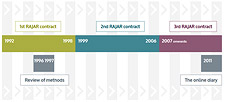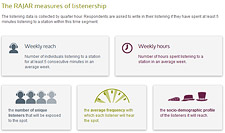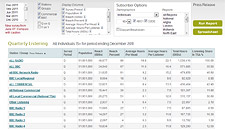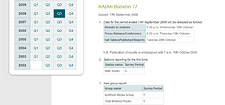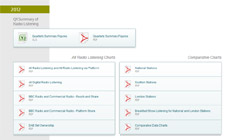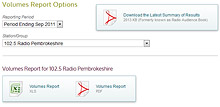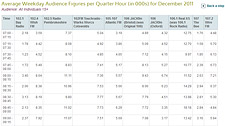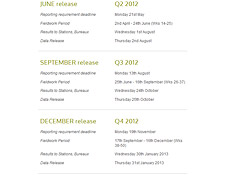Sampling and fieldwork
Definition of Universe
The universe comprises all individuals aged 10 and over living in private households in the United Kingdom. Individual radio services have their own Total Survey Areas (TSAs) defined within this. From 2007, the building blocks for stations to determine their TSA has moved from postcode sector to postcode district. All TSAs are then overlaid and non-overlapping segments are created to produce the sampling framework.
Sample Design
Creating segments
The segments are the pieces of jigsaw that are formed by the overlap between stations TSAs. Therefore each segment represents a unique pattern of radio stations available for listening.
Number of assignments
The adult (15+) population of each TSA is divided by its required sample size, as dictated by the rate card, to produce its diary requirement (e.g. for a station with a population of 100,000, its diary requirement is 500 diaries per year) and finally its assignment requirement (using the same example and assuming each assignment yields 10 diaries, this station would need 500 / 10 = 50 assignments per year).
The number of assignments is optimised so as to deliver the smallest number of assignments such that the effective sample size for all TSAs will be at least as large as their requirement. The effective sample size for a TSA is the sample size after accounting for necessary weighting effects caused by any disproportionate sampling of the segments that make up that TSA. The sample is drawn to quarterly targets and builds up to balanced 6 monthly/yearly samples.
Selecting Sample Points
The basic units for sampling point selection are Output Areas (OAs), which are the smallest geographical unit of information available from the census. Each OA is a unit of around 125 consecutive addresses. Each RAJAR sampling point consists of a pair of OAs, usually about half a mile apart, which are issued together.
Within each segment, all Output Areas are listed in order by:
- Postcode District
- Quadrant
- Ripple
- Population
Then Sample Frames are constructed within each segment, by listing each Output Area in order by Postcode District, Quadrant, Ripple and Population.
The TSA Sampling Interval is defined as follows:
Sampling Interval = TSA Population / Assignment requirement.
(so using the sample example of a TSA of 50,000 with a yield of 10 diaries per assignment and therefore an assignment requirement of 50 (500 diaries / 10 diaries by assignment), SI = 50,000 / 50 = 1,000. Therefore we need to sample every 1,000th person in this station’s TSA to generate the required number of respondents).
The first Output Area is selected at random. Then based on the Sampling Interval for each segment, consecutive Output Areas containing the n’th person further down the list are sampled (where n = Sampling Interval). The assignments are then allocated to individual Quarters and Weeks within Quarters.
In addition the selected OAs are controlled to represent the ACORN profile of the segment as a whole (or Net Local Radio Areas when segments are too small), and also an additional geographical check ensures that the number of sampling points remains constant in each postal town.
Setting Quotas
The final stage of sampling entails the setting of quotas for each sampling point based upon the household and population profile of each pair of OAs. Quotas are set for adult respondents (15+) based on age, sex, working status and household size. For ethnic origin, minimum targets are set from Census and Labour Force Survey data.
Respondent Selection
Starred Addresses
Each interviewer is issued with up to 150 addresses selected from the Postcode Address File (PAF), up to 75 from each OA (Output Area) forming the sampling point. Every fourth address is asterisked - these are priority addresses at which interviewers make two calls. The rest of the addresses are used as substitutes. Stringent rules are applied for the use of the primary and alternative addresses to maximise the spread of interviews across the whole sampling point.
At each sampling point the interviewer is required to place diaries with one household member aged 15+ at a total of 15 households. In addition, up to two children (10-14) may be selected per household, up to a maximum of five per assignment.
If the recruited adult is aged 25+ and a 15-24 year-old lives in the same household, then interviewers may also recruit the 15-24 year-old. Only one 15-24 year-old can be recruited in this way per assignment.
As with all large-scale surveys, RAJAR faces an ongoing and increasing challenge to adequately represent certain sub-sectors of the population, notably young people and certain ethnic groups. RAJAR takes a pro-active approach to these groups, trialling a range of procedures designed to improve representation. One procedure, now a permanent part of the survey, that has seen an increase over recent years is targeted enumeration.
Targeted enumeration
Snowballing is used to recruit, in particular, 15-24 year olds from the list of 150 addresses. This means interviewers are allowed to ask respondents if they know of any 15-24 year olds living nearby. If the provided address is listed within the Output Area, interviewers are allowed to recruit from it, even if the address isn't starred.
Each assignment is accompanied by a quota sheet, reflecting the demographic composition of the area, and interviewers are incentivised to return an assignment within the boundaries of the set quota.
Special boosts are also in place for the following targets: 15-24s, Men 25-34s, Asians, and Welsh.
Placement Procedure
Information is collected by means of a seven day self-completion diary. Diaries are personally placed with one selected adult (15+) and up to two children aged 10-14 years (according to the number of children present) in each selected household.
Diary placements tend to take place between Thursday and Sunday immediately prior to the Diary Week which starts on Monday
All paper diaries are personally collected on the Monday or Tuesday immediately following the Diary Week. The online diary survey week closes the following Monday after placement.


